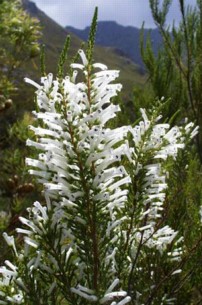|
Prince of Wales Heather A lovely
plant commonly known as the Prince of Wales Heath
with the genus of Erica and the species perspicua
makes its home in the Fynbos Mediterranean biome.
This biome is foundon the southwest tip South
Africa at latitudes 33° to 35° South, and
longitudes 17° to 20° East. The Fynbos
Mediterranean biome is not full of thick underbrush
and forest, even though the forest like evergreen
tree is the most common plant in this biome. Fires
burn throughout the biome, which is an important
reason that Fynbos plants survive. Fire clears any
thick underbrush that may stop small plants from
growing. These fires are naturally and humanly
made. Plants need the space to grow where the
underbrush would be. This biome's plants also grow
in acidic soil. January is
the hottest month in the Fynbos biome, because it
is in the The Prince of Wales Heath likes to grow in sandy, acidic and mostly poor soil that has excellent drainage. It cannot grow in heavy clay soil, yet may tolerate damp soil. It does best in full sun. The Prince of Wales Heath grows in large groups. The plant prefers a warm, dry climate. The Prince of Wales Heath also grows when it is hot. It is frost tender, which means that it is unable grow in the cold weather and cannot survive through frost. The Prince of Wales Heath can be from twelve inches tall to six feet tall and is a bush like tree shrub. It grows upright and out to the sides like a bush. It can be up to three feet wide. The leaves of Erica perspicua are a lot like an evergreen's. They have a needle like width and are one eighth to one half of an inch long. The leaves are gray green, hard and prickly. Flowers on the Prince of Wales Heath are tubular and flared out at the tips, shaped somewhat like a bugle. They are one half to three fourths of an inch long and have a thin width. The flower's color can be rose pink, white, pink and white, and red and white. These translucent flowers grow in spike like, loose bunches at the end of stems. They can be up to three inches long. The flower bunches are scattered around the plant on the ends of many of the stems. When the seeds are in the ground, not all of them will grow into a flower. These seeds can grow at any time of year. The Prince of Wales Heath cannot stand up straight when there is too much water on the roots. The roots are shallow and fibrous. They never run very deep. The Prince of Wales Heath has adapted so that it can live in an area with naturally occurring and controlled fires, dry summers, and winter rain. Other adaptations are in the root system in that they can survive dry summers by storing water. The plant will not take total dryness or extreme ground wetness such as flooding. The species Erica are the most common in the Fynbos Mediterranean Biome, so the Prince of Wales Heath is most likely not endangered. Other reasons why the Prince of Wales Heath is not endangered are that the plant has adapted to the biome. Bees are attracted to this plant, so they pollinate it and help it to grow and reproduce. Also, not many hungry, trampling, large game animals live in the Fynbos biome, so the plant has a very slim chance of being eaten or trampled upon. The plant is also protected. The plant's protectors are people, who watch its growth, learn more about it, and are aware of the Prince of Wales Heath's needs. Special areas are reserved for biome plants such as this one. Three organizations involved in its protection are Mont Eco Nature Reserve, Nautilus Bay Coastal Reserve and Fernkloof Nature Reserve. This beautiful, flowering plant in the Fynbos Biome deserves to be protected and has many unique characteristics that are important to its survival and its hardiness. We should learn more about the Prince of Wales Heath in order to understand how it grows and enjoy its beauty. by Bethany P. 2003
bibliography: Brickell, Christopher, and Zuk, Judith D. "Erica." American Horticultural Society A-Z Encyclopedia of Garden Plants. 1997 ed. Brickell, Christopher. "Erica." The American Horticultural Society Encyclopedia of Garden Plants. 1990 ed. "Fernkloof Nature Reserve." http://www.fernkloof.com/species.mv?39 (16 Dec. 2002) "Countries in the Region." Encyclopedia of World Geography. 1994 ed. "HyperDic Online English Dictionary>erica." http://www.hyperdic.net/dic/e/erica/.shtml (16 Dec. 2002). Kelly, John, and Hillier, John. The Hillier gardener's guide to trees and shrubs. Great Britain: David and Charles Publishers, 1995. "Mont Eco Nature
Reserve - Climate and Weather." "Mont Eco Nature Reserve - Our Plantlife." (Rev. Apr. 02). http://www.monteco-nature-reserve.com/plantlib.htm (19 Dec. 2002). "Nautilus Bay Coastal Reserve." http://www.nautilusbay.co.za/mosselbay.php (19 Dec. 2002). "Prince of Wales heath - Ansme.com Dictionary (define)." http://define.ansme.com/words/p/prince_of_wales_heath.html (16 Dec. 2002). Sunset National Garden Book. Menlo Park, CA: Sunset Books, Inc., 1997. Wyman, Donald. "Erica." Wyman's Gardening Encyclopedia. 1978 ed.
|
